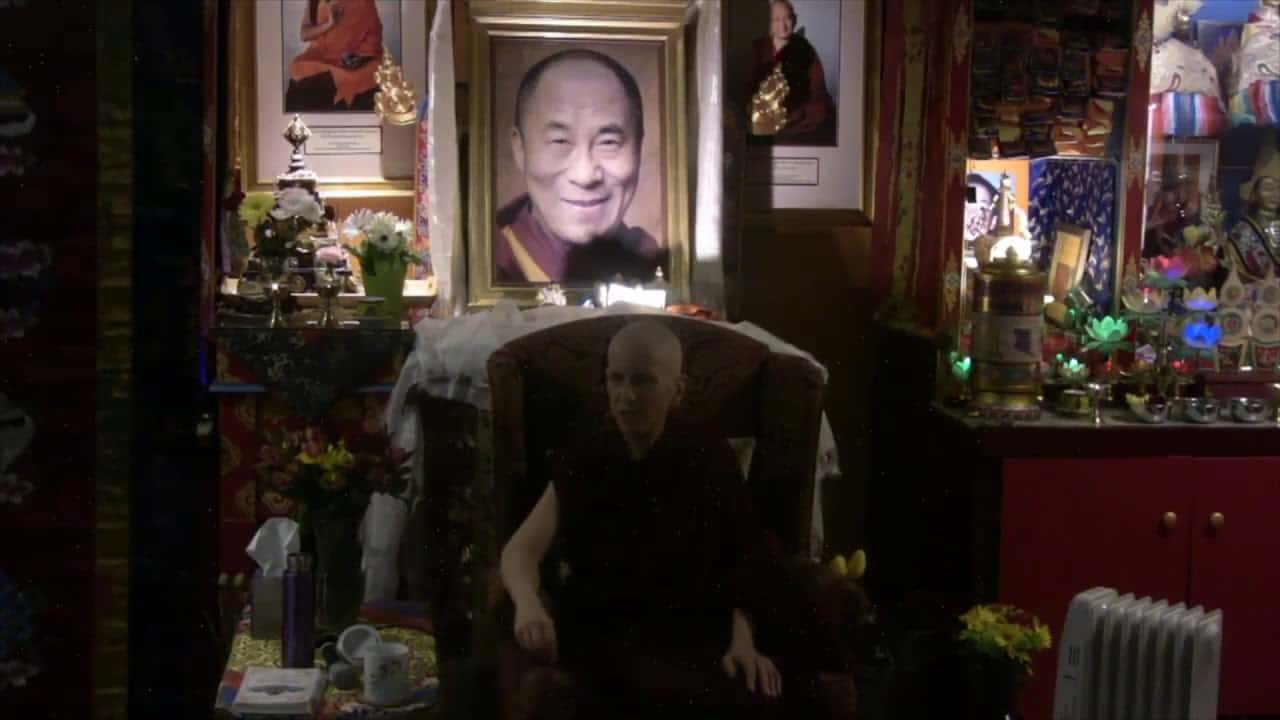The heart of generosity
The preliminary practice (ngondro) of offering water bowls


Heather filling water bowls at Sravasti Abbey in February, 2016. (Photo by Sravasti Abbey)
For me, the water bowl ngondro (preliminary practice of offering 100,000 water bowls) was a very different practice than prostrations, Vajrasattva, and refuge. Perhaps it was because of the purification done in the previous practices, but it generally felt very open and expansive. I can’t say that it was better or less difficult. Many obstacles arose, both internal and external. Some days I really connected to the practice, others days I simply didn’t or I was exhausted or my mind was heavily afflicted. But there’s something about coming to these preliminary practices each and every day without fail, about each and every one of those sessions being different regardless of whether “different” was deeply inspiring or left me feeling frustrated and failing in my aspiration. There is so much strength in continuity, in coming back again and again and again, in habituating ourselves with one practice over a long period of time. The thing is… it can’t help BUT change the mind. It can’t help BUT influence the way I view and interact with the world. And of course, that is what I experienced again with this ngondro.
Lama Zopa, in his booklet detailing the water bowl ngondro, described a way of visualizing each step in the process, but said it was only one of many ways of visualization. What I ended up doing for the duration of this practice was to use the four water bowl steps to contemplate the four ways of gathering disciples:
- As I wiped each bowl to prepare it for the water, I thought about how we prepare the minds of sentient beings to receive the teachings by being generous to them first.
- As I poured water into the first bowl and then poured all but a little into the next one on down the line, I thought about how when we speak kindly and teach the Dharma to sentient beings, we leave a trace, like little drops, on their mindstreams that can ripen later on.
- As I filled each water bowl completely, I thought about how the Dharma flourishes and is “full” in sentient beings’ mind when we encourage them to practice virtue through hearing, thinking, and meditating on the teachings.
- As I poured the water our of each bowl out wiped it dry, I thought about how important it was to eliminate my own faults and purify my own mind by practicing the teachings myself, and how that effort is of great benefit not only to me, but to all sentient beings.
Admittedly, even after all this time, it still sounds remarkably arrogant and grossly premature to be focusing on “ways of gathering disciples,” but since the first time I heard this teaching, there’s just something about it that has always called to me, inspired me. These four, all increasingly powerful acts of generosity, are how I aspire to engage with the world, to connect with sentient beings, and so I stayed with it. It seemed like such a perfect complement to the extensive offering practice. (See Pearl of Wisdom, Book I, p. 48 for the extensive offering practice.)
For me, the extensive offering practice, like the four ways of gathering disciples, was all about connecting with sentient beings, creating an environment where their suffering was subdued to a degree that they could practice with clarity, peace, and contentment in their hearts, where they could cultivate the merit and wisdom to quickly attain the path. I tried to really get into the visualization, to imagine what such a place might be like for me, for groups of beings in the various realms, and for individuals I know who are suffering the weight of their ignorance, afflictions, and karma.
I found it incredibly beneficial to do the extensive offering practice several times within the same meditation session with fewer water bowls instead of doing many more bowls. Coming back to refuge and bodhicitta again and again in each session, getting up from the cushion again and again, just like in life, practicing how I want to engage with the world… up and down off the cushion, from refuge to bodhicitta, to the four ways of gathering disciples and back to refuge, over and over… Over time, this habituated a new kind of focus in my mind, a purpose and clear direction for how I want to live, the aspiration to embody a heart of generosity.
The three years that have spanned this particular practice have not been easy ones in my personal life. Thankfully grief, when coupled with even a beginner’s wisdom about the realities of samsara, can provide the spark for deeper practice. And so it came to be that quite naturally, time cultivating generosity on the cushion began to influence life off the cushion. Little by little, I was able to nudge myself beyond my normal comfort zone and I began to learn from my own personal experience that there is an enormous difference between what looks like an act of generosity in the world and a true heart of generosity. No surprise that this came down to being able to identify the afflictions in my own mind and thus get clean-clear about my motivation.
Interestingly enough, there were also times when stepping back from a situation and not acting was the greater generosity. Not acting as an act of generosity, however, was by far a more delicate endeavor. The first time I realized that I was declining to help someone, not because it was most beneficial, but because I was angry, was a real breakthrough for me. That’s when I first really knew the difference between acting generous and having a true heart of generosity. Inspired, each call for help that followed was imbued with a little more wisdom, a wisdom I was able to share with others in my family as we deliberated on how best to move forward through each crisis with joy and kindness, inspiring and encouraging each other, despite our different faiths.
Being able to really live that heart of generosity requires watching my mind vigilantly, seeing the afflictions as my real enemy, and growing skillful at identifying and applying antidotes to them. Most of my lamrim meditations and off-the-cushion reflections focused on this truth because when the afflictions are subdued, I have so much space for virtue, to live the very life I aspire towards—one of generosity, kindness, joy, flexibility, resilience, endurance, and wisdom. Combining this effort with the daily water bowl practice using the four ways of gathering disciples as my inspiration, I feel more joy, more hope, more inspiration to embrace and embody the heart of generosity for my own happiness and for the benefit of all.
Heather Mack Duchscher
Heather Mack Duchscher has been studying Buddhism since 2007. She first started following Venerable Chodron's teachings in January 2012 and began attending retreats at Sravasti Abbey in 2013.


